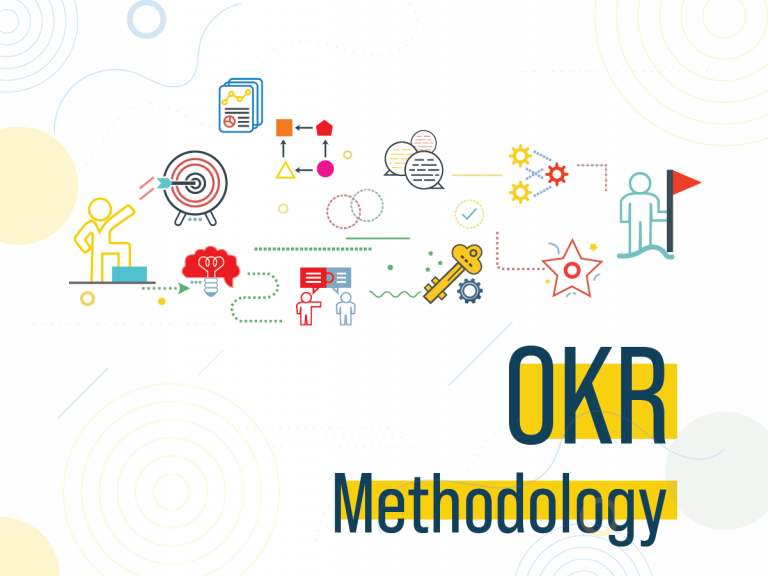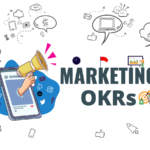
In the recent past, most companies have realized the need for setting specific goal systems that are quick to achieve, simple to understand, flexible, and transparent. The traditional goal-setting process has lost its charm in the hybrid workspace because of a lack of flexibility to change, and effectiveness. That’s where OKRs find prominence.
OKR Methodology
The OKR methodology was created by Andy Grove at Intel, however, they first became well-known and widely adopted after John Doerr published his 2017 book “Measure What Matters: How Google, Bono, and the Gates Foundation Rock the World with OKRs”. And ever since has been widely used by giants like Netflix, LinkedIn, Adobe, Spotify, and Facebook to ensure a company-wide goal alignment and enact their strategies. In order to thrive in business, it is important to be focused on tasks and goals. These companies did just that, and they did so well that not only did they survive, but they thrived. They also moved their company in a unified direction, making them great examples to follow.
What are OKRs?
OKR is a management methodology to ensure that everyone within the organization is headed in the same direction with clear priorities and in a progressive constant rhythm.
“OKR is a collaborative goal-setting process used by teams and individuals to outperform their job by setting clear and measurable goals.” Regardless of the team or a function or any level in an organization, the OKRs work the same for everyone. OKRs help track progress, create alignment and motivate individuals and teams to deliver their best.
“90% of the field studies confirm that challenging goals boost performance and productivity”- American Psychological Association.
Why are OKRs crucial for business performance?
In this new era of remote work, employees very often tend to feel disengaged and demotivated. Having an OKR framework helps them to laser focus efforts that lead to higher business growth and productivity. In a small business, how an individual’s contribution impacts the overall business is easy to understand, however that is not the case with medium to large enterprises. As more and more moving parts are added to the company, OKRs are what keep these different parts moving in one direction and towards a common goal. OKRs help companies-
- Align individuals, teams, and company on larger goals.
- Prioritize and de-prioritize work in case something urgent comes up.
- Track progress, motivate, and give direction to employees.
- Help employees meet their career milestones.
- Plan async work to reduce context-switching and increase productivity.
Components of OKR and examples
According to the Deloitte Review, “No single factor has more impact on employee engagement than clearly defined goals that are written down and shared freely”. OKRs, short for Objectives and Key Results, have the aforementioned 2 components as the name implies.
A good rule of thumb for setting an OKR is – OKR = (Objective = “What”) + 3 x (Key Results = ”Hows”)
A single OKR generally has 1 high-level objective, with another 3-5 key measurable results against that objective.
Objectives are broader goals of the business or department, while key results (KRs) are specific steps towards achieving the objectives. Now, let us look at a few high-level OKR examples –
Example #1 –
Objective: Achieve $1 mn ARR by end of the quarter
- Key result 1: Increase velocity of deals, from current 100 per month to 200 per month in the 3 months.
- Key result 2: Reduce churn from 30% to 25% by end of the quarter.
- Key results 3: Increase marketing qualified leads by doubled in the quarter.
Example #2
Objective: Reduce churn from 30% to 25% by end of the quarter
- Key result 1: Premium customers churn from 15% to 12% – by providing the identified features.
- Key result 2: Better positioning, so that the immediate churn customers (during first week) are reduced from the current 10% to usual 3%.
- Key result 3: Better the support SLA from 90% to 95%.
Example #3
Objective: Launch new product successfully – 1 paid customer by the end of the quarter
- Key result 1: Beta testing with less than 5% defect-density.
- Key result 2: Successful first customer onboarding within the first month of the quarter.
- Key result 3: Prospect 10 customers for the beta testing by mid of the quarter.
How to implement OKRs?
Setting up a culture of healthy OKRs can seem quite daunting at first. However, with a proper framework in place, you can use the principles of OKRs to create a positive culture that will lead to organizational success.
- Familiarize yourself and your team with OKRs
Prior to implementing OKRs, familiarize yourself with the concept of OKR and their benefits. Make sure that you understand the importance of these metrics in measuring performance. You may also choose to do a pilot run, which can help you find out if your team is ready for it, and ensure that everyone on your team understands their role in achieving key results. - Tie OKRs to larger company goals
OKRs must be in line with the organizational objectives in order to be successful. OKRs express what tactics the teams and individuals will deploy, and what results they will need to achieve in order to help the organization realize its long-term objectives. - Put the customers first
The backbone of any successful organization is its customers. As such, customer satisfaction should be the top priority when setting OKRs. An effective OKR will focus on maximizing customer experience that results in an improved bottom line. - Set specific and measurable KRs
Key Results that are specific and measurable help in tracking progress and ensuring we are on track to achieving the set objectives. - All OKRs should be accountable
Key results with no proper accountability will be as good as not having any at all. Having accountability for the OKRs ensure ownership and encourages actions and responsibility.
To Wrap Up
Setting OKRs and completing OKRs is not the end. OKRs are a continuous process that tries to bring out the best in each individual and team. And each quarter, once the OKRs have been achieved, you should evaluate. Ask yourself and your team if the objectives were ambitious enough, and the key results measurable? If any OKRs were ignored, why were they ignored? Did something else come up on priority? Check with your employees if they are all still aligned with business strategy and feel invested in the OKRs. These aforementioned steps set the organization for success by directing employees and setting expectations for the coming quarters.

